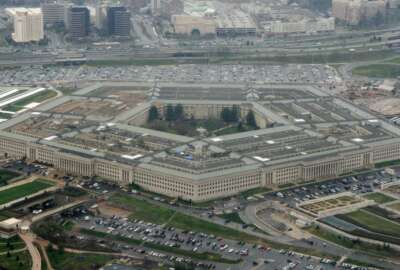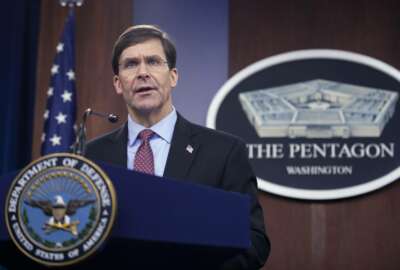What the FY 2022 Defense budget request says about a future fight with China
When Pentagon leadership discusses the rising threat of China, are they putting military dollars where their mouths are? For answers, Federal Drive turned to Govini...
Best listening experience is on Chrome, Firefox or Safari. Subscribe to Federal Drive’s daily audio interviews on Apple Podcasts or PodcastOne.
Strategy is easier to state than it is to budget for. So when the Pentagon leadership discusses the rising threat of China, are they putting military dollars where their mouths are? For answers, Federal Drive with Tom Temin turned to analysis of the budget by Govini, and its senior vice president, Jim Mitre.
Interview transcript:
Tom Temin: Jim, good to have you back.
Jim Mitre: Thanks so much.
Tom Temin: And you have done a detailed analysis through the Govini magic algorithmic engine, I guess you could call it, and came up with a very detailed analysis of the military budget as proposed for 2022. But, what does it say about that big question, namely, the threat of China as a military force?
Jim Mitre: Yeah, thanks, Tom. Just briefly, context, in terms of what we did, every year, we put out a scorecard that looks at the budget in a different way than the way the department presents it. And that’s because, to your point on the magic here, the magic is machine learning. And we apply that to the data in a way that allows us to extract unique insights that you wouldn’t get just if you look at it the way the department puts out the budget. And so this year what we wanted to do was basically examine what the department’s core investments are that relate to its ability to engage in war. What are the core elements of warfare that’s investing in? And it covers five different categories. Organize, which is really about recruiting, training and maintaining the force. Outfit, which is about equipping the force for war. Offset, which is also about the weapons of war, but it’s focused really on those that are going to change the character of war. So think cyber, unmanned systems, artificial intelligence. Operate, which is about the missions the department’s engaging on a daily basis. And then overhead, which covers institutional support from military not directly related to warfighting. Now, to your specific question, we learned a great deal in going through this exercise. And the main thing that jumped out at us is, it’s clear that the department wants to prioritize investments for China. It’s considered the pacing threat for the armed forces. And, in many ways the budget does go about doing that. But, the surprise for us is that there’s more growth investments that are going to help organize the force and in overhead, than there are for the goods of equipment and weapons of war that you would have in order to outfit the force or offset competitors.
Tom Temin: And when you say that there is a relatively large amount devoted to organizing, that’s defined as recruiting, training, maintaining the force, including U.S. military pay, education, training, equipment maintenance, and security assistance for allies and partners. That’s the Govini definition there. But in some ways, don’t all of those activities ultimately support whatever it is the strategy that the Pentagon planners see as important?
Jim Mitre: Yeah, so everything here is necessary for the department to successfully execute its strategy. The question is what the right balance is. And so when it comes to something like organize, all those things, of course, are important. But, the department’s budget grew 1.6%. And its investments in military personnel grew 2.7%. Right? That trend has been happening over the last five years, where investments and military personnel exceed the amount of departments overall budget is growing. And what that means is that then there’s less resources available to offset competitors, or to outfit the force with the key weapons of war that they need. That’s the dynamic that we’re seeing playing out.
Tom Temin: Sure. You don’t want a two million man standing army if all they have a squirt guns to take to the battle in other words
Jim Mitre: No, that sounds a little bit like the North Korean army…
Tom Temin: [Laughing] Good, well, let’s leave them that way. But with respect to those investments that do point to taking on China, what are some examples of that type of procurements or other programs?
Jim Mitre: So there’s a variety of thoughtful and smart investments the department is making here to that end, and in the offset portfolio, which again, are the key investments the department needs to make to change the character of warfare, we’re seeing an interesting shift in the mix of investments. So, over the last couple of years, the department’s investing much more in information-type of capabilities, that’s computers, that’s data, that is AI, command and control, things of that nature, less in some of the physical kind of traditional hardware that the department would look to develop. And that shift really started in the 2020 time period. There’s a pretty pronounced change there. But it’s been cemented by this budget. And within the outfit portfolio, for example, the only area, the department’s really seeing an increase in investment besides nuclear weapons, is in C4ISR and IT systems, which jumped a big amounts 7.8%.
Tom Temin: I was gonna say yes, and by the way, we’re speaking with Jim Mitre, senior vice president of Govini. If China was to try to do something truly offensive against the United States, it would probably begin, in their estimation possibly end, with what they would do in cyberspace. So, these investments that you mentioned, do they also include cyber offensive capabilities, so far as we can tell?
Jim Mitre: Yes. It includes the range of cyber capabilities, offensive, defensive. To some extent, when it comes to cyber, it’s sometimes a little bit hard to draw the line, it might be conducting defense by being more forward leaning, if you will. But yes, this does cover the range of the department’s cyber investments.
Tom Temin: Because we would want to take out China’s C4I systems before they could take out those of the United States.
Jim Mitre: Right. So to your point here, who knows exactly what a future war with China could look like. That’s part of the problem is that the department hasn’t engaged in a great power war in quite some time, right? Really since back to World War II. And hasn’t planned for in a serious way since the Cold War. And so as it’s starting to refocus on what great power war could look like against China, there’s a question of how that might start. And certainly, there’s reason to believe that it would be advantageous for either side, the Chinese, or the Americans, to try the blind the other, to try the deaf the other, to try to mute the other by attacking their space based, air, ground based communication systems.
Tom Temin: All right. And with respect to those investments that are offset related, are they pretty much across the board, Army, Navy, Air Force, or is one particular armed service getting more of this than the others
Jim Mitre: Well, the Air Force over the last few years has been investing the most in what we define as offset type capabilities. But there is an interesting wrinkle with the ’22 budget, where their investments in artificial intelligence actually drop a bit, about 21%, relative to where they had been, and it’s the other military departments that are investing a little bit more, as well as the organizations in the Office of the Secretary of Defense, such as DARPA.
Tom Temin: And what’s going on with some of the kinetic investments such as the new presumed bomber that would be coming in sometime, the B-23 or whatever they call it? And then also things like, we just saw news reports of Russia having some kind of super fast kinetic missile, is that also happening in the U.S. military?
Jim Mitre: Right. So within the FY ’22 budget, what the department tried to do is actually cut investments in its legacy forces as a way to free up resources that they can invest into more modern capabilities, like the new bomber. And we certainly did see that. The Air Force again, for example, cut about 200 airplanes from its inventory. Now the first question is whether or not Congress will stand for that. And there’s a decent chance some of those proposed cuts by the department aren’t actually accepted and we’ll find a way back in to the budget once Congress finishes its work. But, to the extent that we’re seeing the department’s proposal out there and what they’re trying to do that with that money, while some of it is going into modernizing the force with new capabilities like the bomber, the surprising thing is that more of that money was actually shifting out of the outfit investments and getting into organizing to overhead. Overhead, for example, within this budget jumped 6%, which is non trivial in a one-year time frame.
Tom Temin: Because in many ways, they have no control over some of those costs. Pensions, health care.
Jim Mitre: That’s right. There are certainly some structural dynamics that lead to annual increases in overhead costs. But one of the dynamics we’ve noticed is that the department had, over the last few years, really put a focus on reform. And it might be that that effort is running out of steam. So if you look at the Army’s night court process, for example, which is the label they use for their reform work, each of the last three years, the amount of savings they found has gone down. And, over the last year, the Congress eliminated the position of the office of chief management within the Department of Defense, whose primary responsibility was to look for reform. And so, it could very well be the case that the low hanging fruit is gone and those easy kills within the program and easy ways to find efficiencies are removed. But, not having that same concerted focus on it could lead to further cost growth. And that’s the concern that we’re trying to flag here. Six percent jump in one year, given the fact that overall, overhead dollars are still somewhat consistent with historical norms. It might be okay. But what we don’t want to see is that 6% jump each of the next five years, right? That would be problematic.
Tom Temin: And getting back to the China pivot, if you will. I think that’s a word from the Obama administration, the pivot to Asia. Who’s paying for this? That is to say, nobody thinks that there will be a large ground war with China and a giant army. So is the army paying for the pivot?
Jim Mitre: Yeah, great question, Tom. And you’re right. When it comes to the Pacific, there’s more water than land. And so the general expectation is that the Air Force and the Navy, to include the Marine Corps, would be doing a lot more in a China war fight than the Army. And so as a result, there’s been an expectation that the Army’s budget is going to be cut. And people kind of been waiting for that to happen over the last few years. And what we’ve seen in this budget is that there is a decrease in the Army’s investments in operate by about 10%, which is significant. But that is really reflecting the drawdown of troops from Afghanistan and the broader Middle East. And it really only amounts to about $3.3 billion dollars of savings. So, it’s not enough to pay for the necessary modernization and posh investments the department’s going to need in order to effectively deter Chinese aggression in the western Pacific. And whether or not the department will revisit the Army’s topline in the FY ’23 cycle is going to be a big question and an area to continue watching.
Tom Temin: And what about the Navy in all of this?
Jim Mitre: Well, the Navy has been trying to maintain its readiness and get past this point in time where we’ve had a series of catastrophic collisions out at sea, given the fact that the training and maintenance on naval ships has not been what it should be. And one of the surprises that we’ve noticed in the budget is that the Navy is continuing to invest in operate funds, which is the funds you need to deploy your forces out at sea. And so what they’re not doing is decreasing the tempo of operations so that their folks would be back at station more able to train, or back, you know, the ships would be back in port [and] able to get maintenance. There is an increase in maintenance funding. And that seems to be the way in which the Navy is trying to get after the readiness challenge. But it is another area to watch and question whether or not the Navy can sustain the current level of operational tempo that it has, given the fact that it’s forestructure is decreasing?
Tom Temin: Yes, because there is, I guess, still in place a strategy for a larger Navy by 100 or so ships. And with that comes the need for people that are trained to man the ships.
Jim Mitre: That’s exactly right.
Tom Temin: And any signs that that’s still the strategy and still the budgeting priority?
Jim Mitre: It does not appear that the department’s on a path towards a 355 ship Navy. It seems that this administration is prioritizing the capabilities of the ships that are out there, and to your point, training and maintenance of those ships, as opposed to trying to grow the capacity and get to a larger number for the sake of it. So there is certainly a preference for capability here. And I’d be surprised if that changes in a meaningful way in FY ’23, barring significant intervention by Congress.
Tom Temin: And just a final question, contractors looking at this budget and looking at the Govini analysis, what should they take away with respect to strategy for supporting the military and positioning themselves to get military dollars?
Jim Mitre: I think the big takeaway here is that overall, the department’s topline is relatively flat at 1.6%. Perhaps it’s going down a little bit once you factor in inflation. And so from a contractor perspective, the question is, what is the shift in the mix of capabilities the department’s going to seek? And, here what we’re seeing is clearly a shift more towards information type of capabilities. It’s less of the traditional hard power, hardware, infrastructure type of investments, much more in terms of data, AI, computing, and command and control information, along the lines of what we discussed. And so if you’re a contractor out there, trying to figure out which way to focus, it seems very clear that the trend line is more in that direction. And some of the prominent initiatives the department is unveiling here, really bring that to the fore. So, Joint All-Domain Command and Control, JADC2 is a key priority for the department, and you see it not just within one military department, the Air Force has been the first one out of the gates there, but the Navy, the Army, they’re all coming around to that and investing more in that space.
Tom Temin: Jim Mitre is senior vice president of Govini, thanks so much for joining me.
Jim Mitre: Thank you, Tom. It’s been a pleasure.
Copyright © 2025 Federal News Network. All rights reserved. This website is not intended for users located within the European Economic Area.
Tom Temin is host of the Federal Drive and has been providing insight on federal technology and management issues for more than 30 years.
Follow @tteminWFED







